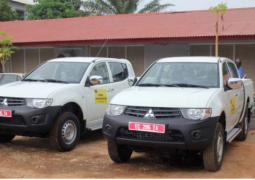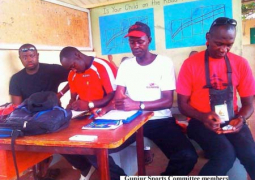They said all hands must be on deck in ensuring that Vision 2016 is achieved, so as to end the decades-long importation of rice in this country, come 31 December 2015.
In an interview with some of the agriculture projects directors, during a meeting held at the Chamen Seed Multiplication Centre in the North Bank Region, regarding the role and contribution of each project towards the realization of Vision 2016, the project coordinator of NEMA, Momodou Gassama, stressed that Vision 2016 “is possible and together we can do it.”
The country has the resources such as vast potential land to produce more crops, he said.
“We also have the resources in terms of water, which is also part of the solution to the problem, and the number of projects, particularly the NEMA project that is going to develop a lot of land for rice cultivation,” he said.
PIWAMP has also done a lot of work in that aspect of supporting Vision 2016, he said, adding that they work to develop agricultural land suitable for rice production in many areas.
PIWAMP has also done the construction of causeways and bridges, and a lot of land which is yet to be fully utilize, he stated.
Gassama said putting all this together, and considering what the NEMA project is going to do, he has no doubt that the vision would be achieved.
According to Mr Gassama, it was part of the NEMA project’s strategic plans to develop 2,000 hectares of land, which is going to be over a period of 7 years ending in 2019.
He disclosed that from 2014 to 2015 NEMA would develop something like 353-360 hectares of tidal irrigation fields.
They have already signed a contract for the development of 160 hectares in 2014 and another contract was also signed to develop another 1000 hectares.
In 2015 NEMA is thinking of developing another 1000 of hectares, and about 200 hectares of tidal irrigation which would go a long way in supporting the Vision 2016 objective.
Gassama expressed his impressions about the rice, maize, millet, groundnut, sesame and beans in fields visited at the Chamen Seed Multiplication Centre in the NBR and Garawol in Kantora District in Basse URR.
He thanked the Department of Agriculture under the Director General of Agriculture for conducting such a field visit activity, and thanked the WAAPP project for supporting the Chamen Seed Multiplication Centre.
The project coordinator WAAPP, Lamin Jobe, also stressed that Vision 2016 is achievable if they have all hands on deck “as everybody has a role to play.”
At the project level, what they can do is to facilitate to make sure that farmers are well-guided about their role and responsibility by building their capacity, and to create the conducive environment for them.
According Jobe, WAAPP has provided 1,229 metric tonnes of seeds such as rice, findi, maize and groundnuts that were distributed across the country.
WAAPP also distributed 21,000 bags of fertilizer, which included compound fertilizer and urea.
All the fields visited in Chamen received seeds from WAAPP and “have grown very well,” he said.
Mr Jobe challenged everybody to redouble efforts to cultivate more rice fields and other varieties of food crops so s to be self-sufficient.
He said there will be more support to farmers to work towards the realization ofVision 2016.
Falalo Touray, project coordinator of GCAV, who also doubles as the project coordinator CPCU, said the purpose of the field visit was to show farmers the best practices, and what the best practisers can achieve in groundnuts cultivation.
The delegation was in Garawol village in URR to see what the women were able to do in improving and increasing rice production, he said.
After visiting the various farmers’ fields, he was “very impressed” about what was cultivated on the ground by the centre staff, and that the purpose of the trek was to popularise Vision 2016.
They also encouraged farmers, so that they share the concept and take ownership of the concept.
Mr Touray said the vision is possible, because there is political backing and all depends on the people of the country to work together.
He said the farmers have demonstrated their commitment to ensure that the vision is realised, and the technicians are also ready to play their part.
As the coordinator of the CPCU representing the projects, he assured farmers and the government of the project staff’s commitment and of the project’s support to ensure that the vision is realized.
The project would do everything to ensure that its mandate is achieved.
This includes support to micro-finance enterprises, and to help the government achieve the objectives of national food and nutrition security.
“We will put all hands on deck and ensure that the government is being supported to achieve its objectives,” he declared.



